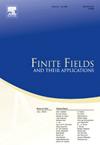具有第三大可能属q的极大函数域的Weierstrass半群和自同构群 ≡ 1 (mod 3)
IF 1.2
3区 数学
Q1 MATHEMATICS
引用次数: 0
摘要
在这篇文章中,我们继续[3]中开始的工作,明确地确定在任何地方的Weierstrass半群和已知的具有第三大属的fq2 -极大函数域Y3的完全自同构群,对于q≡1(mod3)。这个函数场是厄米函数场的伽罗瓦子场,它的唯一性(相对于它的格值)是一个众所周知的开放问题。了解weerstrass半群可能是解决这个问题的关键。令人惊讶的是,Y3有许多不同类型的Weierstrass半群而且它的Weierstrass位的集合比它的fq2 -有理位的集合要丰富得多。我们证明了在自同构方面不会出现类似的异常行为,即,除了q的小值外,Aut(Y3)正是从厄米函数场继承的自同构群。本文章由计算机程序翻译,如有差异,请以英文原文为准。
Weierstrass semigroups and automorphism group of a maximal function field with the third largest possible genus, q ≡ 1 (mod 3)
In this article we continue the work started in [3], explicitly determining the Weierstrass semigroup at any place and the full automorphism group of a known -maximal function field having the third largest genus, for . This function field arises as a Galois subfield of the Hermitian function field, and its uniqueness (with respect to the value of its genus) is a well-known open problem. Knowing the Weierstrass semigroups may provide a key towards solving this problem. Surprisingly enough, has many different types of Weierstrass semigroups and the set of its Weierstrass places is much richer than its set of -rational places. We show that a similar exceptional behaviour does not occur in terms of automorphisms, that is, is exactly the automorphism group inherited from the Hermitian function field, apart from small values of q.
求助全文
通过发布文献求助,成功后即可免费获取论文全文。
去求助
来源期刊
CiteScore
2.00
自引率
20.00%
发文量
133
审稿时长
6-12 weeks
期刊介绍:
Finite Fields and Their Applications is a peer-reviewed technical journal publishing papers in finite field theory as well as in applications of finite fields. As a result of applications in a wide variety of areas, finite fields are increasingly important in several areas of mathematics, including linear and abstract algebra, number theory and algebraic geometry, as well as in computer science, statistics, information theory, and engineering.
For cohesion, and because so many applications rely on various theoretical properties of finite fields, it is essential that there be a core of high-quality papers on theoretical aspects. In addition, since much of the vitality of the area comes from computational problems, the journal publishes papers on computational aspects of finite fields as well as on algorithms and complexity of finite field-related methods.
The journal also publishes papers in various applications including, but not limited to, algebraic coding theory, cryptology, combinatorial design theory, pseudorandom number generation, and linear recurring sequences. There are other areas of application to be included, but the important point is that finite fields play a nontrivial role in the theory, application, or algorithm.

 求助内容:
求助内容: 应助结果提醒方式:
应助结果提醒方式:


